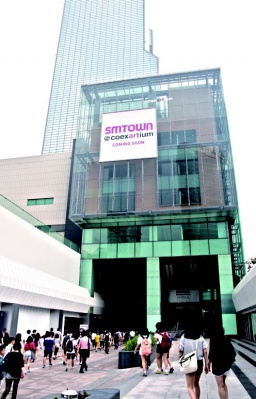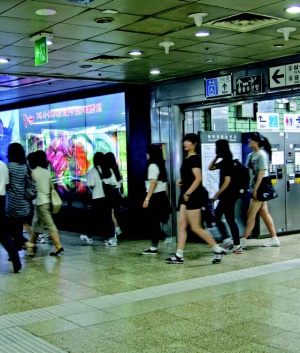"Seoul - 6.4 Consumer Culture of the Subway Station Vicinity Areas"의 두 판 사이의 차이
잔글 |
|||
| 1번째 줄: | 1번째 줄: | ||
| + | {{Navbox | ||
| + | |서명= [[Understanding Korea materials - Seoul|Seoul]] | ||
| + | |시리즈명= [[한국이해자료#Understanding Korea Series|Understanding Korea Series No.4]] | ||
| + | |이전= [[Seoul - 6.3 Culture of Recreation and Past Time|3) Culture of Recreation and Past Time]] | ||
| + | |현재= [[Seoul - 6.4 Consumer Culture of the Subway Station Vicinity Areas|4) Consumer Culture of the Subway Station Vicinity Areas]] | ||
| + | |다음= [[Seoul - 6.5 Education-oriented Culture|5) Education-oriented Culture]] | ||
| + | }} | ||
| + | |||
| + | |||
The subway system is a complex mass transit system that connects the city like a cobweb. It makes moving around the city convenient for the citizens of Seoul and enable them to maintain secure daily lifestyle in this city with 10 million. Since the opening of Line Number 1 in 1974, 9 more lines have been added. It is connected to 293 stations and covers a total distance of 316.8 kilometers. Once all planned light rail lines open up, all citizens of Seoul would have a subway station that is located within 10 minutes of walk from their homes. Because of this convenience factor, everyday activities of the citizens of Seoul including the commute, shopping and meetings happen around the subway stations. Convenience facilities such as large-scale shopping centers, restaurants and movie theaters opened up in the subway station-influenced areas with many transient commuters forming a new type of consumer culture. | The subway system is a complex mass transit system that connects the city like a cobweb. It makes moving around the city convenient for the citizens of Seoul and enable them to maintain secure daily lifestyle in this city with 10 million. Since the opening of Line Number 1 in 1974, 9 more lines have been added. It is connected to 293 stations and covers a total distance of 316.8 kilometers. Once all planned light rail lines open up, all citizens of Seoul would have a subway station that is located within 10 minutes of walk from their homes. Because of this convenience factor, everyday activities of the citizens of Seoul including the commute, shopping and meetings happen around the subway stations. Convenience facilities such as large-scale shopping centers, restaurants and movie theaters opened up in the subway station-influenced areas with many transient commuters forming a new type of consumer culture. | ||
| 11번째 줄: | 20번째 줄: | ||
If Myeong-dong is the consumer center of tourists, Gangnam Station area would be the main consumer space for the young people living in Seoul. There are clusters of clothing shops in the underground shopping mall in Gangnam as well as private academies, famous plastic surgeons, restaurants and movie theaters. Gangnam Station which is easily accessible has been established as a haven for young people: there are not only trendy fashions and foods that can satisfy any taste but also movies and musicals that quench cultural desires and 24-hour entertainment readily available to blow away daily stress. | If Myeong-dong is the consumer center of tourists, Gangnam Station area would be the main consumer space for the young people living in Seoul. There are clusters of clothing shops in the underground shopping mall in Gangnam as well as private academies, famous plastic surgeons, restaurants and movie theaters. Gangnam Station which is easily accessible has been established as a haven for young people: there are not only trendy fashions and foods that can satisfy any taste but also movies and musicals that quench cultural desires and 24-hour entertainment readily available to blow away daily stress. | ||
| + | |||
| + | |||
| + | {{틀:UKS Seoul}} | ||
2017년 1월 19일 (목) 22:24 기준 최신판
| Understanding Korea Series No.4 | ||
| ← Previous | Seoul | Next → |
| 3) Culture of Recreation and Past Time | 4) Consumer Culture of the Subway Station Vicinity Areas | 5) Education-oriented Culture |
The subway system is a complex mass transit system that connects the city like a cobweb. It makes moving around the city convenient for the citizens of Seoul and enable them to maintain secure daily lifestyle in this city with 10 million. Since the opening of Line Number 1 in 1974, 9 more lines have been added. It is connected to 293 stations and covers a total distance of 316.8 kilometers. Once all planned light rail lines open up, all citizens of Seoul would have a subway station that is located within 10 minutes of walk from their homes. Because of this convenience factor, everyday activities of the citizens of Seoul including the commute, shopping and meetings happen around the subway stations. Convenience facilities such as large-scale shopping centers, restaurants and movie theaters opened up in the subway station-influenced areas with many transient commuters forming a new type of consumer culture.
The areas round subway stations with large number of daily commuters are crowded day and night. They include Gangnam Station (198,000), Jamsil Station (163,000), Sadang Station (159,000), Seonneung Station (156,000), Samseong Station (137,000), Express Bus Terminal (129,000), Seoul National University of Education Station (128,000) and Yangjae Station (100,000). Gangnam Station is the transfer station for Sinbundang Line coming in from Bundang/Yongin, and Sadang Station is the transfer station for Line Number 4 coming in from Anyang/Pyeongchon. These two stations are especially crowded. Many young people use Yangjae Station, which is the transfer station for Line Number 3 and the starting point of commuter bus lines to the university campuses that relocated out of Seoul (Sungkyunkwan University, Kyunghee University, Myongji University, etc.); this station is the transportation hub that connects people of Gangbuk and the Han River shoreline to the metropolitan area.
- Photo 35 Coex Mall Connected to Samseong Station
If Myeong-dong is the consumer center of tourists, Gangnam Station area would be the main consumer space for the young people living in Seoul. There are clusters of clothing shops in the underground shopping mall in Gangnam as well as private academies, famous plastic surgeons, restaurants and movie theaters. Gangnam Station which is easily accessible has been established as a haven for young people: there are not only trendy fashions and foods that can satisfy any taste but also movies and musicals that quench cultural desires and 24-hour entertainment readily available to blow away daily stress.

